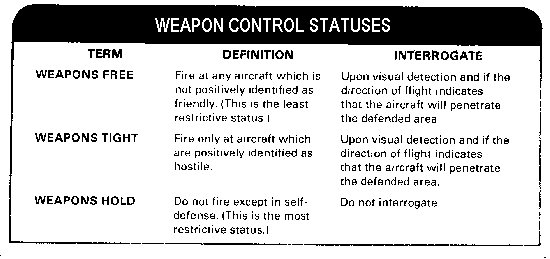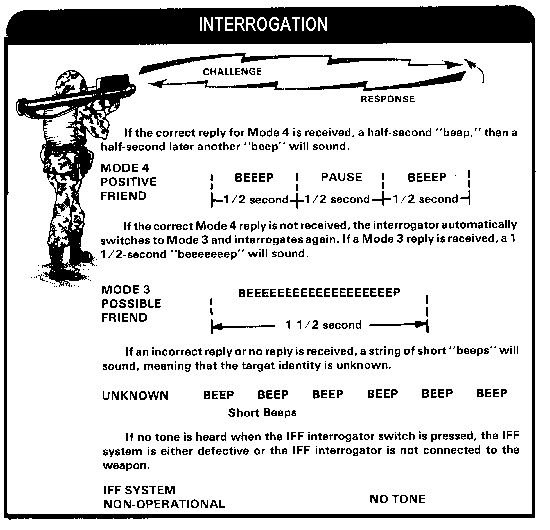CHAPTER 4
Aircraft Detection
To successfully accomplish an engagement, the Stinger team must be proficient in detecting and identifying aircraft. This chapter focuses primarily on the methods and techniques used in detecting aircraft. Because the identification function is an integral part of the engagement sequence, it is discussed, where appropriate. However, it is not discussed in detail. Aircraft recognition training is covered in FM 44-30. FM 44-18 tells how to employ the Stinger missile system, including how to apply rules of engagement, which include hostile criteria. Also covered are the various weapon control statuses (WCS) and the procedures to follow in making the decision on whether or not to fire at an aircraft.
VISUAL DETECTION
The first step in a Stinger engagement is visual detection of the target. This may be done by either member of the team. A Stinger team may be warned of approaching aircraft by the forward area alerting radar (FAAR) system or the early warning broadcast net. The Stinger team receives the warning on the FM receiver on the target alert data display set (TADDS) or on the R-442 auxiliary receiver. In any case, the target location must be made known to the gunner. When warning of the approach of unknown aircraft is received, the Stinger team can narrow its search sector to the general direction from which the aircraft is coming. The range at which aircraft may be detected will vary due to several circumstances. The following are some circumstances which will affect aircraft detection:
|
CONTENTS |
TERRAIN MASKING
Since Stinger gunners are on the ground, the local terrain will influence the distance at which low-altitude aircraft will unmask; that is, not be hidden behind a hill or other feature. Terrain mask should be kept in mind when selecting a site.
AIRCRAFT CHARACTERISTICS
The main features of an aircraft that affect detection range are--
METEOROLOGICAL CONDITIONS
Rain, snow, dust, fog, smoke, heat shimmer, and haze tend to reduce visibility and so tend to reduce the range of visual detection of aircraft.
VISUAL ACUITY
Observers are required to detect, recognize, and identify small objects at long ranges. Therefore, they must have good eyesight. Their eyes should be rested periodically (about every 15 minutes) to prevent fatigue and to maintain alertness. Binoculars have little value in detection because they have narrow fields of view. This increases the time required to search a given area of space. Binoculars may help to identify a target after it has been detected. See appendix B for use of binoculars.
SEARCH SECTOR
Search sectors should be as small as possible and still have good coverage to both sides of the expected avenues of target approach. When alerted to an approaching target, the search sector should be reduced and concentrated in the general direction of the expected approach.
HOW TO SEARCH
An observer's capability to detect aircraft increases as the size of the search sector assigned decreases. Detection is more likely if an observer is assigned responsibility for searching a narrow sector than if he is responsible for searching the entire area surrounding his position. If an alert warnings system is supporting the observer, he may be assigned a fairly large sector (for example, 90°) for general surveillance. When a warning is received, he then narrows his search sector (for example, 30°) and centers it on the aircraft's approach azimuth. Decreasing the sector size to less than 30° is not advisable because the alert warning system azimuth data may not be accurate. An error of only a few degrees may cause the observer to miss an aircraft. Often observers, using the horizon as a reference, tend to concentrate their search near the horizon and disregard objects high above the horizon. Therefore, when assigning search sectors, the sector should be defined in both horizontal and vertical planes.
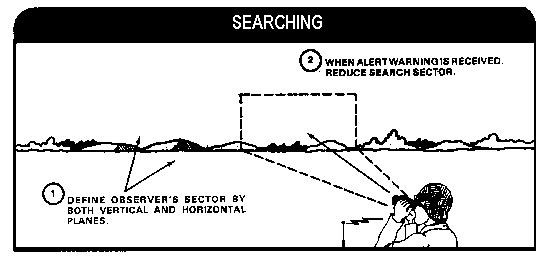
A simple way to estimate how high above the horizon to search is to use the hand. Facing the PTL, extend either the left or right arm fully and extend the fingers. The tips of the thumb and little finger should form a line perpendicular to the ground. Now, when the little finger is touching the horizon, the tip of the thumb is approximately 20° above the horizon.
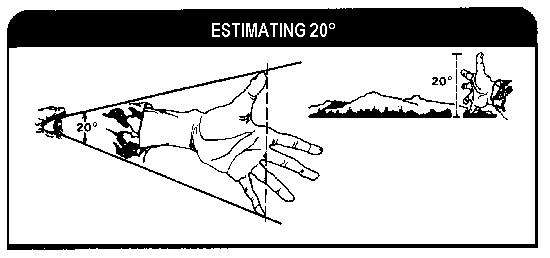
The observer should frequently focus his eyes on a distant object, such as a cloud or terrain feature (otherwise, the eyes tend to relax and distant objects become blurred).
Search the area near the sun by extending arm and hand as to block out the sun's glare. (Looking into the sun without shielding the eyes will cause them to become blinded for a few seconds. This may prove to be critical, because the observer may lose sight of the target.)
The observer should squint his eyes if he has trouble focusing at long ranges. Squinting compresses the eyeballs, thus changing their focal length and making distant objects come into focus.
The observer should keep his eyes on the aircraft once he sees it. If he has to look away from it, he notes the direction of the aircraft and moves his eyes away from it when the aircraft is near some object, such as a cloud or a terrain feature, that will guide his eyes back to it.
Observers may use one of two systematic methods of search to look for aircraft in any type of terrain.
In the first method, the observer searches the horizon to about 20° (356 mils) above the horizon by moving his eyes in short movements across the sky, working his way up and across. He continues the scan pattern to below the horizon to detect aircraft flying nap-of-the-earth.
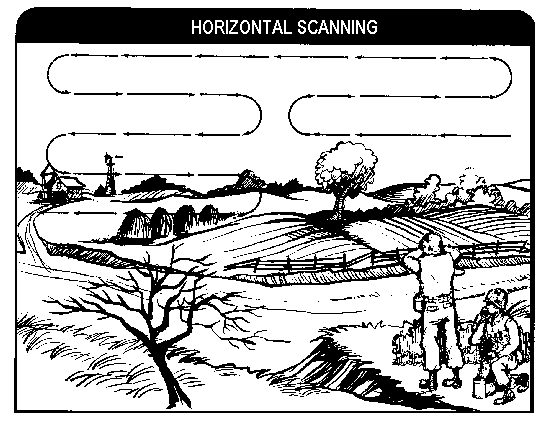
In the second method, the observer searches the sky using the horizon as a starting point and prominent terrain features as of points of reference. He moves his eyes in the short movements up the sky, then back down, continuing this movement across the terrain. He scans in the same pattern below the horizon to detect aircraft flying nap-of-the-earth.

Observers with more experience and above average visual efficiency may use nonsystematic methods of search that work best for themselves such as--
When the Stinger team occupies a tactical position, each team member will take turns searching for aerial targets. This allows one member to search while his partner rests his eyes and provides ground security. Search sectors are arranged to provide all-around coverage of the entire area and overlapping coverage of the assigned sector of fire on likely approach routes. When an alert warning is received, both team members shift primary search emphasis to the azimuth of approach (with frequent all-around scans) until one member detects the target.
At times, the Stinger team will be assigned a sector of responsibility by the Stinger section chief or the supported unit commander. When two or more teams are defending a unit in position behind the line of contact, the Stinger team normally concentrates its search for aircraft along these avenues. At other times, the Stinger team will search for aircraft as specified by local SOP or as required by the situation. This is common when a Stinger team is defending a convoy. This is also common when it is supporting a maneuver unit which is in contact with or moving to contact with the enemy.
WHERE TO SEARCH
A map reconnaissance of the supported unit's direction of movement or area of operation will help to pinpoint areas from which aircraft are most likely to attack the unit. Mark the far sides of woodlines, ridgelines, and significant folds in the terrain out to at least 3,000 to 5,000 meters. This is where attack helicopters can lie in wait at the maximum range of their antitank guided missiles (ATGM). Mark restricting terrain--defiles and narrow valleys--where the unit may be forced to pinch together, becoming lucrative targets for air attack.
WITH MANEUVER UNITS
When accompanying maneuver units in contact or moving to contact with the enemy, the Stinger team usually concentrates its search for aircraft in the general direction of the enemy ground forces and occasionally searches the entire horizon. Other unit personnel should also be constantly alert to the possibility of attack by enemy aircraft. Again, the team chief marks the route of advance and monitors the TADDS and the radio for warnings of approaching aircraft.
TELL-TALE SIGNATURES
Many aircraft have tell-tale signatures which can lead to early detection. Stinger teams should look for the following:
AIRCRAFT INTERROGATION
Exactly when to interrogate an aircraft depends upon the WCS in effect. The WCSs are shown in the illustration below.
Rules of engagement do not prohibit a unit or air defense weapon from shooting at an aircraft that is attacking it--the right of self-defense is never denied. (The engagement decision is covered in chapter 5.)
Interrogation techniques are as follows:
AIRCRAFT IDENTIFICATION
Firing a Stinger missile at an aircraft must be IAW specific hostile criteria. (Normally, the responsibility for target identification rests with the team chief.) The identification must be completed before the team chief can issue a command to engage. The gunner may complete the engagement sequence up to firing, but he will not fire without having first received an order to engage from the team chief. When operating as part of a split team or if the team chief becomes a casualty, the gunner must assume identification responsibilities. After an aircraft has been detected, it must be identified as friendly, hostile, or unknown.
If the aircraft is declared friendly, it must not be engaged (except in self-defense).
If the aircraft is declared hostile and is within range, it must be destroyed (except under a condition of WEAPONS HOLD). However, the right to fire in self-defense is never denied.
If the aircraft is unknown, the engagement decision is based on the WCS, application of hostile criteria and techniques of fire.
HOSTILE CRITERIA
Recognition of the aircraft by name or country of manufacture is a start, but it is by no means conclusive. For example, the Mirage III/V is made in France; however, it is in service in 23 countries in Europe, the Middle East, Africa, Australia, and South America. Other aircraft are similarly spread throughout the world, including many made in the United States. Target identification as hostile must be based on visual inspection of the target and its assessment against specific hostile criteria. The exact criteria in use may vary with the tactical situation, from command to command, and in terms of time and space. For example, the TSOP may classify
as hostile those aircraft that are--
Note: If the WCS is WEAPONS FREE, gunners will engage aircraft responding improperly to IFF interrogation unless constrained by headquarters/command directives/SOPs.
- Discharging smoke or spray.
- Discharging parachutists or unloading troops in excess of normal aircraft crew.
- Engaging in mine-laying operations.
ADDITIONAL CONSIDERATIONS
Unauthorized or improper entry into an area designated as restricted or prohibited could prove dangerous or lead to personnel injury and aircraft loss. Care should be exercised in applying this criterion. This is necessary to avoid engaging a friendly aircraft that has been damaged and is retiring to the rear of our lines. Also, it may have inadvertently strayed into the restricted area due to a navigational error.
Aircraft operating at prohibited speeds or altitudes, or in prohibited directions, can pose a real problem to an observer. The determination of aircraft speed and altitude by ground observers is difficult. Extreme care should be used in applying this criterion.
An aircraft bearing the military markings or having the configuration of an aircraft employed by a known enemy nation may also pose a real problem to the Stinger missile team. In this case, the criteria used by the Stinger team must be based on visual inspection of the aircraft. Since aircraft markings are not usually visible at long ranges, most identifications must be made on recognition of the physical features of the aircraft. To eliminate any element of doubt, both team members must be capable of recognizing friendly as well as enemy aircraft. (For detailed discussion of aircraft recognition, refer to FM 44-30.)
|
NEWSLETTER
|
| Join the GlobalSecurity.org mailing list |
|
|
|


